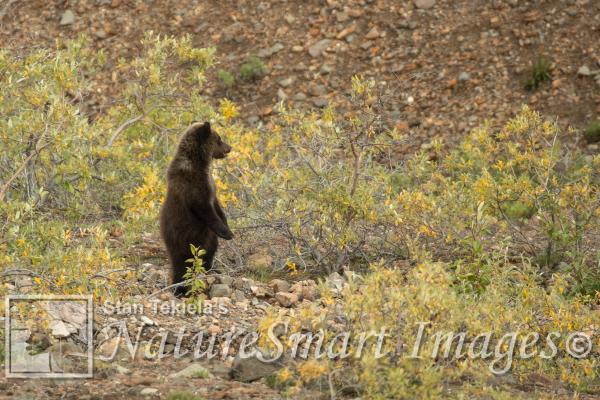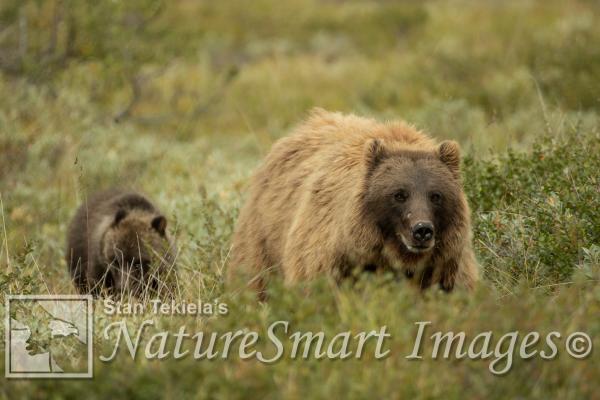View all of the titles in the
NatureSmart Bookstore


by Stan Tekiela
© NatureSmart
October 8, 2018
Every trip I take to Alaska is special. When it comes to wilderness and wildlife, Alaska is the real deal. This year’s trip was no exception. Moose are often what I spend my time searching for but this year I concentrated on bears: Grizzly bears to be more specifically.
We have three types of bear in North America, the Black Bear, Brown Bear and Polar Bear. The Grizzly Bear is a type, or more accurately, a subspecies of brown bear. They tend to be the smallest of the brown bears. The name “grizzly” doesn’t have a clear origin. It seems that originally it was spelled “grisley” and referred to the grey or silver tips of the hair. The more modern spelling “grisly” refers to it being “fear-inspiring” or “fearsome”. Of course I think either interpretation equally describes this amazing bear.
Over my 30 plus year career in wildlife, I have had many encounters with black, brown and polar bears. I still find them endlessly fascinating and beautiful. They are one of my most favorite subjects to study and film.
This year I had many wonderful opportunities to study and photograph Grizzly Bears in Alaska. Most of it took place in and around Denali National Park. Most of the bears I encountered with females, which are called sows. All of them had at least one cub. Several had two cubs. Best off, the cubs were “spring cubs” which means the cubs were born this past spring, so they were still very small and super cute.
Grizzly Bear cubs are born while the mother is still in the den during late winter, usually in February. So these cubs were just 6 months old. As a result they were super curious and playful. They would follow their mothers anywhere and stick close by their sides.
One day, while I was filming a mother and single spring cub, the mother found a root of a tree sticking out of a dry river bank. She started chewing and scrapping at the knurled root. For some reason, this activity scared the spring cub, which sent the frightened cub running away from its mother.
The cub wasn’t more than 30 yards away from the mother but couldn’t clearly see what she was doing. The mother continued to bite and then roll around on top of the root depositing her scent and fur. The cub looked and acted to confused, often running back a few yards than standing up and trying to see what was going on with his mom.
I was able to capture some images before the mother got up and started to walk up the dry river bank and into the cubs view. As soon as the cub saw its mother it started running to catch up to her but suddenly caught a whiff of the scent post the mother had just laid down.
The cub approached the exposed and now torn-up root and suddenly starting doing exactly what the mother was doing. It was biting and rolling around on the root which now was rather beat up. The mother kept walking away and as soon as the cub noticed the mother was still walking away, quickly got up and ran after her.
The sow and cub started walking across the tundra straight for me. Usually the bears will stop and feed for a while before moving on but this mother had some place in mind she wanted to go and was heading that way. I was able to capture a number of images as the bears approached but needed to retreat before they came dangerously close.
I must tell you that when you are all by yourself in the wilderness and you are looking through a long lens of a camera, which makes the bears look much closer than they actually are, it’s a bit unnerving.
Each and every time I have an encounter with a bear I feel such respect towards these amazing animals and this time was no exception. I can’t wait to return to Alaska. Until next time…
Stan Tekiela is an author / naturalist and wildlife photographer who travels the U.S. to study and capture the beauty of nature. He can be followed on www.facebook.com twitter.com and can be contacted via his web page at www.naturesmart.com
The nationally syndicated NatureSmart Column appears in over 25 cities spanning 7 states: Minnesota, Wisconsin, Michigan, Illinois, Ohio, New York and Pennsylvania. It is a bi-weekly column circulated to over 750,000 readers.
Wolves
Just the day before, a pack of wolves known as the Wapiti, had found a large bull bison that was weak and injured. Based on its size, this big boy was near the end of its lifespan and the winter weather was taking its toll. For a full day the wolves tried to approach the bison but when the bison...
Moose
It was one of those dark and cloudy winter days in Yellowstone National Park where the clouds are so heavy and low, you feel like you can reach up and touch the cloudy sky. A light wind helped to blow the falling snow with occasional gusts of wind causing swirls of fluffy white snow...
American Badger
It’s funny, I believe the average person knows more about the Honey Badger (Mellivora capensis), a critter of Africa and Southwest Asia than they do about the badger in our own backyard, the American Badger (Taxidea taxus). Social media has a lot to do with the Honey Badger phenomena and...
Backyard Bird Feeding
Winter bird feeding is one of the most common / popular hobbies in America. It is estimated that nearly 60 million Americans feed birds in their yards in winter or summer. That is about 40 percent of all American’s make backyard bird feeding part of their everyday activities. It’s...
View all of the titles in the
NatureSmart Bookstore
Check out Stan's latest photos at
NatureSmart Wildlife Images
Take a tour with Stan.
» More Info
Hear Stan on radio stations all across the Midwest.
» More Info

When he's out in the field, Stan relies on his Vortex Razor binoculars and Vortex Razor spotting scope to help find the subjects for his award winning wildlife photography.

For thirty years, professional wildlife photographer Stan Tekiela has counted on Hunt's Photo and Video to provide him with professional photography equipment.
From tripods to camera bodies and lenses, Hunt's has been Stan's place for everything that he needs. Personal service and prompt shipping means Stan can count on Hunt's to support his professional wildlife photography career.


Professional Wildlife Photographer Stan Tekiela always uses Feeder Fresh in his seed feeders to help keep the feeders and food dry, clean and mold free.
He also uses Feeder Fresh Nectar Defender in all of his hummingbird feeders. It safely keeps nectar fresh longer.